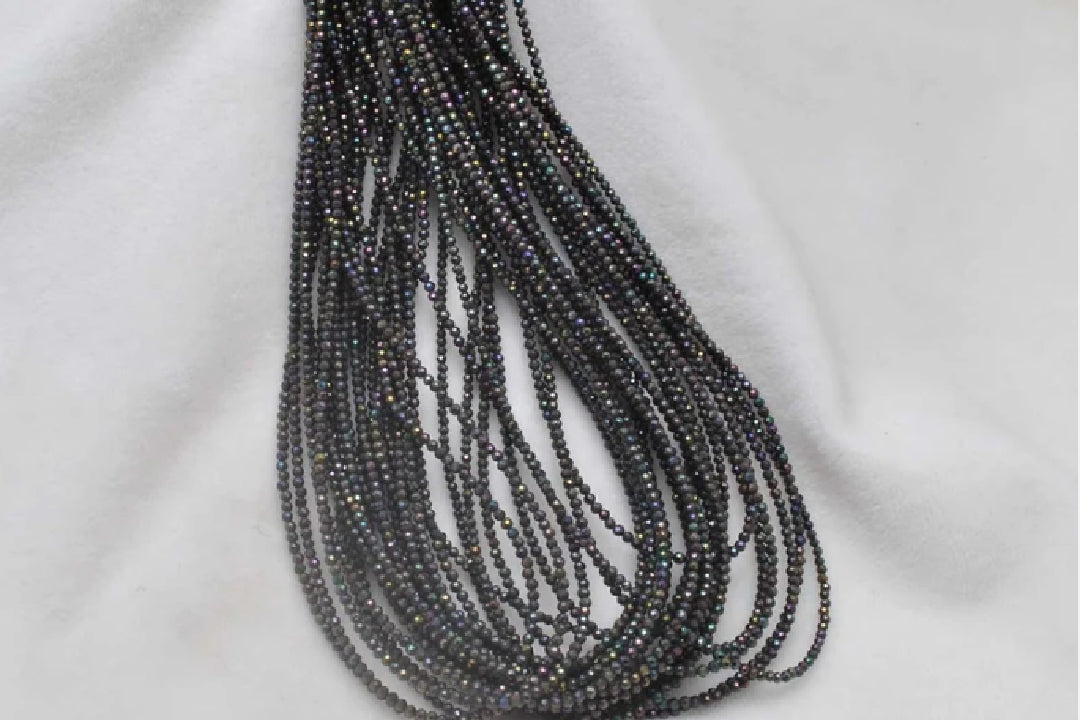
Gemstone Secrets: How to Know If Your Semi-Precious Beads Are Authentic?
Share
Semi-precious beads are the heart of many beautiful jewelry creations. From elegant necklaces to artisan bracelets, they bring color, texture, and story to every design. But not all beads are created equal. With the growing popularity of gemstone jewelry, the market has seen a flood of synthetic, dyed, or imitation beads. For jewelry makers, identifying authentic semi-precious beads is not just about quality—it's about building trust, maintaining integrity, and ensuring long-term value.
In this blog, we’ll guide you through everything you need to know to spot genuine semi-precious gemstone beads for jewelry making and avoid misleading imitations.
What Are Semi-Precious Gemstone Beads?
Semi-precious Gemstone beads are natural mineral-based gemstones that are not classified as "precious" (like diamonds, rubies, sapphires, or emeralds), yet they are still valued for their beauty and rarity. Common types include:
- Amethyst
- Carnelian
- Citrine
- Garnet
- Lapis Lazuli
- Peridot
- Rose Quartz
- Tiger’s Eye
- Turquoise
These gemstone are frequently used in handmade jewelry because they come in diverse colors, patterns, and energies.
Why Fake or Treated Beads Are a Problem?
In the pursuit of low prices and high volumes, many sellers introduce fake, dyed, or treated beads into the market. These imitations may look beautiful at first glance, but often lack the durability and uniqueness of real stones. Here's why it's problematic:
- Deceptive value: You may overpay for a synthetic or low-quality bead, thinking it's natural.
- Fading or damage: Dyed beads can lose color, and glass imitations may chip or break.
- Ethical concerns: Synthetic stones or poorly sourced materials may not follow sustainable practices.
- Trust issues: Customers rely on you to offer genuine products; one bad piece can ruin credibility.
Key Characteristics of Genuine Semi-Precious Gemstone Beads
1. Color & Luster
Wholesale gemstone beads for jewelry making often have subtle color variations. For example, a strand of natural amethyst may include lighter and darker purple tones. Fake beads, on the other hand, may be uniformly colored and appear overly vibrant due to dyes.
Real beads also have a natural luster—a soft glow from within. If a bead seems too glossy or plasticky, it could be synthetic or coated.
2. Weight & Temperature
Genuine stones are usually heavier than plastic or resin beads. If the bead feels unusually light, it's worth inspecting further.
Also, real gemstones tend to feel cool to the touch, even in warm environments. This temperature test is a simple but effective method to weed out fakes.
3. Surface Texture and Inclusions
Natural beads often include inclusions—tiny internal flaws or color streaks. These imperfections are signs of authenticity. Fake beads are often too perfect—clear, flawless, or bubble-filled.
Tip: If every bead in a strand looks identical in shape, color, and clarity, it’s likely not natural.
4. Drill Hole Inspection
Look closely at the drill holes. If the hole appears white while the rest of the bead is colored, it could be dyed. Authentic gemstones have consistent coloring throughout.
Uneven or chipped edges around the hole may also indicate brittle or poorly treated beads.
5. UV Light Test
Some synthetic or dyed beads fluoresce under UV light, while natural stones often do not. For example, some dyed howlite (sold as turquoise) glows bright under blacklight, revealing its treatment.
Advanced Tools & Tests for Verification
While the above methods work well for basic identification, advanced tools provide scientific accuracy, especially for professional jewelers or bulk buyers.
1. Magnifying Glass or Jeweler’s Loupe
This allows you to zoom in and spot fine inclusions, grain structure, or flaws—something the naked eye might miss.
2. Refractive Index Testing
Gemstones bend light in specific ways. A refractometer can measure the refractive index of a stone, which is unique to each gem type. This is one of the most reliable gemstone tests.
3. Mohs Hardness Test
Each gemstone has a specific hardness level on the Mohs scale. For example:
- Quartz: 7
- Turquoise: 5–6
- Amethyst: 7
You can gently scratch the stone using materials with known hardness. Be careful with this method to avoid damage.
4. Specific Gravity Test
This test measures a stone’s density. Real stones tend to be denser than synthetics. A jeweler can perform this using a precise scale and fluid displacement.
Common Treated and Imitation Beads to Watch Out For
Knowing the common fakes in the market will help you be more cautious when buying.
Dyed Howlite as Turquoise
Howlite is often dyed blue to mimic turquoise. It has similar veining patterns but lacks the durability and price tag of real turquoise.
Glass Imitations of Amethyst or Citrine
Glass beads may have a similar color but no internal flaws or crystal structure. They're often too smooth and consistent.
Stabilized vs. Natural Stones
Some soft stones like turquoise are stabilized with resin to improve durability. While not fake, they are not 100% natural and should be disclosed as such.
Reconstituted or Composite Stones
These are made by gluing or melting stone fragments together. They are cheap and can resemble real stones, but are structurally weaker.
Questions to Ask Your Bead Supplier
When sourcing beads, especially in bulk, ask suppliers the right questions to ensure transparency and quality:
- Are these natural or dyed?
- Have they been stabilized or treated?
- Are they synthetic or reconstituted?
- Can you provide gemstone certification?
- What is the country of origin?
Reputable suppliers will answer these questions confidently and provide documentation if needed.
Why Choose Kanika Creations?
At Kanika Creations, we understand how important it is for designers and jewelry makers to work with authentic materials. Here's what makes us a trusted choice for semi-precious beads:
- Authentic Sourcing: We deal only in genuine, ethically sourced semi-precious beads, tested and verified before sale.
- Transparency: All treatments, stabilizations, or enhancements are disclosed.
- In-House Quality Control: Every bead undergoes inspection for quality, durability, and authenticity.
- Bulk Buying Advantage: Competitive pricing for designers, small business owners, and wholesalers.
- Global Shipping: Whether you're ordering from New Delhi or New York, we deliver worldwide with speed and care.
When you buy from Kanika Creations, you’re not just getting beads—you’re getting trust, craftsmanship, and support.
Conclusion
As a jewelry maker, knowing how to identify genuine semi-precious gemstone beads empowers you to:
- Make better buying decisions
- Offer high-quality pieces to your customers
- Build a reputation for authenticity
- Avoid wasting money on cheap imitations
By learning to observe color, weight, texture, and performing simple tests—or buying from reputable suppliers like Kanika Creations—you can ensure that your designs are as real and valuable as they appear.
Frequently Asked Questions
1. How can I tell if a semi-precious gemstone bead is dyed or natural?
Check for color concentration around the drill hole—dyed beads often have uneven or overly vibrant colors. Natural beads display subtle color variations and internal inclusions. You can also rub a cotton swab with acetone on the bead; if it stains, the bead is likely dyed.
2. Do real semi-precious beads feel different from fake ones?
Yes. Real gemstones are usually heavier and cooler to the touch compared to plastic or resin imitations. They also have a more solid, natural luster. Fakes often feel lightweight and warm quickly in your hand, lacking the density of genuine stones.
3. What are common fake stones sold as real semi-precious gemstone beads?
Howlite dyed as turquoise, glass imitations of amethyst or citrine, and resin composites are the most common. These may look convincing, but are usually much less durable. Always ask your supplier about treatments or enhancements, and buy from trusted sources.
4. Are inclusions in a bead a bad thing?
Not at all. Inclusions, tiny cracks, or internal mineral patterns are often signs of authenticity. Unlike synthetic or glass beads, natural stones typically have imperfections that add character. Uniform, flawless beads may be fake or heavily processed.
5. Can I test semi-precious beads at home without special tools?
Yes. You can inspect the bead under a magnifying glass, do a weight and temperature test, or use a blacklight to detect dyes. While not foolproof, these simple methods can help weed out obvious fakes. For full accuracy, consult a gemologist.
